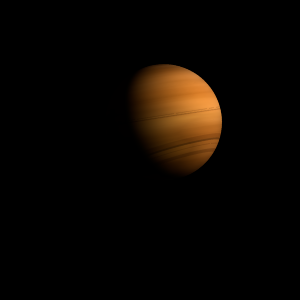|
|
Space Astro
|
Info for exoplanet "Raqrok Epi"
| Scientific (actual) data |
|---|
| Name | NSC J0040-2942 b |
| Planet status | Confirmed |
| Planet mass | 34 |
| Semi major axis | 1095.38 |
| Discovered | 2022 |
| Updated | 2024-06-26 |
| Publication | Published in a refereed paper |
| Detection type | Imaging |
| Alternate names | NSC J004058.68-294212.37 b |
| Star name | NSC J0040-2942 |
| Right ascension | 10.24° |
| Declination | -29.7° |
| Star distance | 42.4 |
| Star mass | 0.097 |
| Star radius | 0.121 |
| Star sp type | M7V |
| Star temperature | 2823 |
| Star alternate names | NSC J004058.68-294212.37 |
| Wikipedia article | NSC J0040-2942 b |
Back
| |
| Fictional info (?) |
|---|
| Suggested name | Raqrok Epi |
| Planet type | Huge cold gas giant |
| As seen from NSC J0040-2942, in a frame of reference that rotates with the orbital motion, it appears to rotate only once every two years.
Because of its rapid rotation, the planet's shape is that of an oblate spheroid (it has a slight but noticeable bulge around the equator).
The surface is known for its odd primordial carnivores, the "Palsaxa Pamar", that survive alone while eating another species called Franre if they can. They are believed to be somewhat related to Mneforn-um but have 6 tentacles and vary in size from 50 to 100 cm. The Palsaxa Pamar can thrive at temperatures from 120 to 160°C and ultra violet light which is common near the poles. |
| Estimated population | 25000000000 |
| Atmosphere | Carbon dioxide | 59% |
| Oxygen | 23% |
| Methane | 17% |
| Water | 0.0026% |
| Atmospheric pressure | 17 bar |
 |
| No known satellites |
| Google search for Raqrok epi |
|
Website by Joachim Michaelis
|
|
|
|